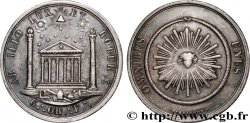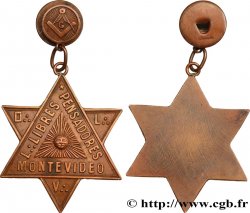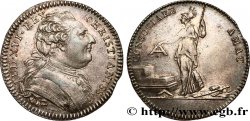fjt_235253 - FREEMASONRY BESANÇON , DIRECTOIRE DE BOURGOGNE n.d.
Not available.
Item sold on our e-shop (2010)
Price : 380.00 €
Item sold on our e-shop (2010)
Price : 380.00 €
Type : BESANÇON , DIRECTOIRE DE BOURGOGNE
Date: n.d.
Metal : silver
Diameter : 30,5 mm
Orientation dies : 12 h.
Edge : lisse
Rarity : R2
Coments on the condition:
Il reste la trace de la bélière que l’on voit sur l’exemplaire de la collection de la GLDF
Catalogue references :
Obverse
Obverse legend : M O Æ.
Obverse description : Écusson portant un crane et M O Æ posé sur un dais.
Reverse
Reverse legend : DIRECTOIRE DE BOURGOGNE - PERIT UT VIVAT.
Reverse description : Phénix sortant des flammes au-dessus d’une banderole qui porte la légende PERIT UT VIVAT.
Reverse translation : Il meurt pour revivre.
Commentary
Les commentaires concernant ce jeton dans le Labouret, qui illustre l’exemplaire de la collection de la GLDF sont particulièrement intéressants car cette loge fut la seule à reprendre ses travaux au Rite Écossais Rectifié. Le directoire de Bourgogne était celui des Chevaliers Bienfaisants de la Cité Sainte, étape ultime du parcours du Rectifié.
La franc-maçonnerie s’implante en France aux alentours du premier quart du XVIIIe s. sous l’influence d’aristocrates anglais. Initiatique, elle est fondée sur le rite hiramique, du nom d’Hiram de Tyr, personnage biblique, architecte du roi Salomon sur le chantier du Temple et qui a résisté à la torture sans livrer ses secrets. Hiram a aussi donné un point de départ du calendrier maçonnique commençant 4000 ans avant le calendrier chrétien. Les symboles servent de signes de reconnaissance entre les initiés, notamment des outils de constructeur de cathédrales (équerre, compas, niveau, maillet, etc.), des formes (triangle, étoile), des nombres (trois, cinq, sept) et des lettres.
La franc-maçonnerie s’implante en France aux alentours du premier quart du XVIIIe s. sous l’influence d’aristocrates anglais. Initiatique, elle est fondée sur le rite hiramique, du nom d’Hiram de Tyr, personnage biblique, architecte du roi Salomon sur le chantier du Temple et qui a résisté à la torture sans livrer ses secrets. Hiram a aussi donné un point de départ du calendrier maçonnique commençant 4000 ans avant le calendrier chrétien. Les symboles servent de signes de reconnaissance entre les initiés, notamment des outils de constructeur de cathédrales (équerre, compas, niveau, maillet, etc.), des formes (triangle, étoile), des nombres (trois, cinq, sept) et des lettres.








 Report a mistake
Report a mistake Print the page
Print the page Share my selection
Share my selection Ask a question
Ask a question Consign / sell
Consign / sell
 Full data
Full data









